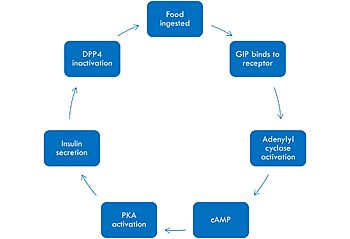User:Mandy Bechman/Sandbox 1
From Proteopedia
(Difference between revisions)
| Line 18: | Line 18: | ||
The mechanism of GIP begins with the ingestion of food. This stimulates GIP to bind to its receptor. Once bound, the activated G alpha protein moves laterally in the membrane in order to activate its target, adenylyl cyclase. Once adenylyl cyclase is activated, it catalyzes the formation of cyclic AMP (cAMP). This molecule activates Protein Kinase A (PKA), which signals the secretin of insulin. After a few minutes of active signaling, this hormone is recognized and inactivated by a peptidase called DPP-4 (dipeptidyl peptidase-4) by cleaving the first two amino acids.<ref name="Mayendraraj"/> | The mechanism of GIP begins with the ingestion of food. This stimulates GIP to bind to its receptor. Once bound, the activated G alpha protein moves laterally in the membrane in order to activate its target, adenylyl cyclase. Once adenylyl cyclase is activated, it catalyzes the formation of cyclic AMP (cAMP). This molecule activates Protein Kinase A (PKA), which signals the secretin of insulin. After a few minutes of active signaling, this hormone is recognized and inactivated by a peptidase called DPP-4 (dipeptidyl peptidase-4) by cleaving the first two amino acids.<ref name="Mayendraraj"/> | ||
===Diseases=== | ===Diseases=== | ||
| - | Malfunction of the GIP protein can result in some serious life-threatening diseases. Overexpression of GIP can result in obesity by promoting fat disposition in adipocyte tissues as well as an inability to regulate food intake and control appetite. Underexpression of GIP can result in diabetes. | + | Malfunction of the GIP protein can result in some serious life-threatening diseases. Overexpression of GIP can result in obesity by promoting fat disposition in adipocyte tissues as well as an inability to regulate food intake and control appetite. Underexpression of GIP can result in diabetes, a disease associated with the lack of insulin biosynthesis, which is vital for energy production. |
===Tirzepatide=== | ===Tirzepatide=== | ||
| - | One of the most promising treatments to GIP malfunction is <scene name='10/1038867/Tirzepatide/2'>Tirzepatide</scene>, also known as Mounjaro, created by Eli Lily. It is an antidiabetic as well as weight loss drug. The structure of Tirzepatide functions as an incretin receptor agonist to GIP by activating GIP's receptor and producing insulin | + | One of the most promising treatments to GIP malfunction is <scene name='10/1038867/Tirzepatide/2'>Tirzepatide</scene>, also known as Mounjaro, created by Eli Lily. It is an antidiabetic as well as weight loss drug. The structure of Tirzepatide functions as an incretin receptor agonist to GIP by activating GIP's receptor and producing insulin. |
[[Image:Sequence.png|400 px|left|thumb|Sequence comparison of the first 28 residues of GIP and Tirzepatide.]] | [[Image:Sequence.png|400 px|left|thumb|Sequence comparison of the first 28 residues of GIP and Tirzepatide.]] | ||
Revision as of 13:29, 25 April 2024
H. sapiens Glucose-dependent Insulinotropic Polypeptide
| |||||||||||
References
- ↑ 1.0 1.1 1.2 Mayendraraj A, Rosenkilde MM, Gasbjerg LS. GLP-1 and GIP receptor signaling in beta cells interactions and co-stimulation. Peptides. 2022 May;151:170749. PMID:35065096 doi:10.1016/j.peptides.2022.170749
- ↑ 2.0 2.1 2.2 2.3 Seino Y, Fukushima M, Yabe D. GIP and GLP-1, the two incretin hormones: Similarities and differences. J Diabetes Investig. 2010 Apr 22;1(1-2):8-23. PMID:24843404 doi:10.1111/j.2040-1124.2010.00022.x
Student Contributors
Mandy M. Bechman Chloe A. Tucker



